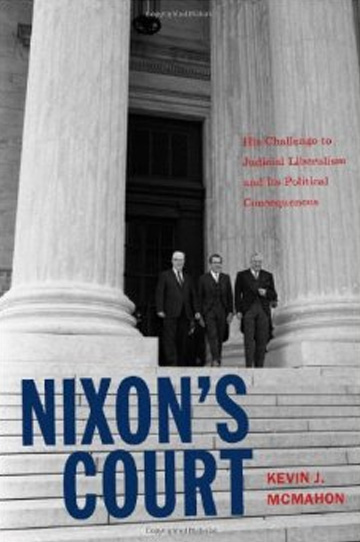
Nixon’s Court
November 1, 2011 | The Barnes & Noble Review
Richard Nixon assumed the presidency in 1969 with a rare gift in hand: a lame-duck chief justice presiding over the Supreme Court. The great progressive Earl Warren had announced his retirement in June 1968 in hopes that Lyndon Johnson could appoint his successor. But the Senate rejected Johnson’s man, Justice Abe Fortas, and soon clouded him in a fog of petty scandals. He retired from the Court in May 1969, and Warren — who had stayed on for an additional term — followed him a month later. Nixon therefore got to appoint two new justices in his first year as president — and he would see two more Supreme Court vacancies in 1971. Three of the four retiring justices had voted as liberals, so the appointments had the potential to transform the Court.
Yet by outward appearances Nixon made a hash of the business. His first appointment, Chief Justice Warren Burger, is universally regarded as a failure both as a leader and a jurist. Nixon’s next two nominees, southern conservatives Clement Haynsworth and Harrold Carswell, were humiliatingly rejected in the Senate. Nixon subsequently appointed Harry Blackmun, who became one of the Court’s most liberal members, and Lewis Powell, a moderate swing voter. The only Nixon appointee who was both conservative and successful was William Rehnquist, whom Nixon hoped would serve for thirty years and one day become chief justice. Ronald Reagan made that promotion in 1986, and Rehnquist served for thirty-three years on the Court. But during Nixon’s presidency Rehnquist was far to the right of his colleagues and often dissented alone.
In Nixon’s Court, political scientist Kevin McMahon offers a new interpretation of Nixon’s judicial policy — that is, his Supreme Court appointments and positions on major legal issues. McMahon contends that Nixon’s judicial goals were more limited than is generally appreciated, and that he largely fulfilled them. Unlike Reagan, Nixon did not launch a full-scale counterrevolution against the perceived excesses of the Warren Court. Instead he used judicial issues mostly for political advantage. McMahon argues that we should judge him by what he did rather than what he said, and that his actions were often moderate compared to his rhetoric. Speaking loudly and carrying a small stick: leave it to Nixon to chart a new path to success.
McMahon establishes that Nixon’s opposition to court-ordered busing and his law-and-order platform contributed to his reelection in 1972. Whereas modern “strict constructionists” treat issues like abortion and school prayer as non-negotiable litmus tests, Nixon deployed Supreme Court politics nimbly and eschewed ideology. He harbored moderate views on civil rights but used desegregation as a wedge to break off southerners and “ethnic” northern Catholics from the Democratic coalition while Patrick Buchanan whispered excitedly in his ear. Nixon was an exceedingly clever politician, and Nixon’s Court shows that he “understood he was governing during an era that demanded ideological caution,” when riots filled the streets and third-party candidate George Wallace perpetually threatened to steal votes.
In recasting Nixon as a moderate conservative on judicial issues, McMahon makes as strong a case as the facts will allow, fairly telling the story and scrupulously acknowledging evidence that undercuts his argument. But that evidence can at times seem overwhelming. McMahon is right that Nixon was no Reagan and certainly no Wallace, and that modern commentators frequently overlook his progressive domestic accomplishments. But Nixon nevertheless made a number of strongly conservative moves that redirected the Supreme Court for generations.
In speeches, Nixon wielded Court politics like a thug with a crowbar. Pandering to the South, he complained of “regional discrimination”; pandering to working-class northerners, he deplored Court-assisted “appeasement” of mob rule and warned darkly about the “barbaric reality” of the “city jungle.” He hammered relentlessly on the busing issue and demeaned the Court by nominating an avowed white supremacist (Carswell) to sit on it. When Leon Panetta — now the Obama administration’s defense secretary, then one of Nixon’s civil rights officials — aggressively moved to cut off federal funds to schools that defied court orders to integrate, Nixon fired him. And Nixon’s Justice Department fought integration in major cases like Alexander v. Holmes County in the South and Milliken v. Bradley in the North, even if, as McMahon points out, it did not participate in every case.
More important, Nixon launched the careers of three of the godfathers of modern legal conservatism: Rehnquist on the Court, and Robert Bork and Antonin Scalia in the Justice Department. McMahon is least persuasive when he tries to downplay the significance of the Rehnquist appointment by artificially separating Rehnquist’s tenure as associate justice (credit to Nixon) from his service as chief (credit to Reagan). McMahon says that different issues faced the country after the promotion in 1986. But race, crime, and federalism are always before the Court, and William Rehnquist made as strong a mark on those issues as any conservative justice since Brown v. Board of Education. Appointing him was one of Nixon’s most consequential decisions.
As a work of political science rather than advocacy, Nixon’s Court ends at description: it contends that Nixon’s judicial policy succeeded politically without saying whether the policy was good or bad. It was bad. Nixon cynically manipulated Supreme Court politics to exploit voters’ worst instincts: division, mistrust, resentment, and prejudice. He was the first president since Brown to fight integration. And he displayed a fickle willingness to use any position that hurt his opponents — even threatening at one point to nominate former segregationist Robert Byrd to the Court so the Democrats would have to reject one of their own senators. (Byrd had never practiced law.) Supreme Court politics have become a circus. For six years Richard Nixon was the ringmaster.